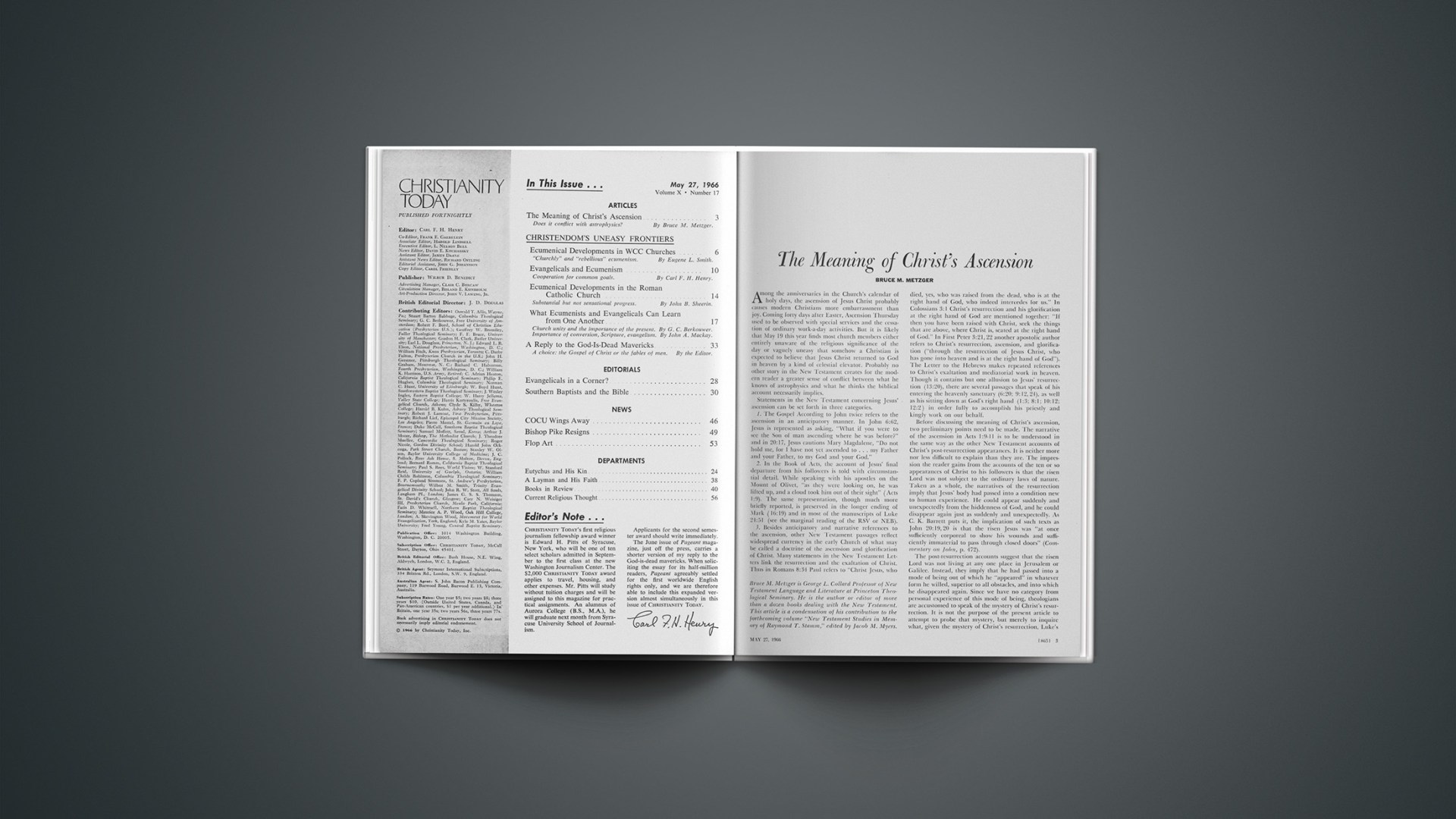Among the anniversaries in the Church’s calendar of holy days, the ascension of Jesus Christ probably causes modern Christians more embarrassment than joy. Coming forty days after Easter, Ascension Thursday used to be observed with special services and the cessation of ordinary work-a-day activities, but it is likely that May 19 this year finds most church members either entirely unaware of the religious significance of the day or vaguely uneasy that somehow a Christian is expected to believe that Jesus Christ returned to God in heaven by a kind of celestial elevator. Probably no other story in the New Testament creates for the modern reader a greater sense of conflict between what he knows of astrophysics and what he thinks the biblical account necessarily implies.
Statements in the New Testament concerning Jesus’ ascension can be set forth in three categories.
1. The Gospel According to John twice refers to the ascension in an anticipatory manner. In John 6:62, Jesus is represented as asking, “What if you were to see the Son of man ascending where he was before?” and in 20:17, Jesus cautions Mary Magdalene, “Do not hold me, for I have not yet ascended to … my Father and your Father, to my God and your God.”
2. In the Book of Acts, the account of Jesus’ final departure from his followers is told with circumstantial detail. While speaking with his apostles on the Mount of Olivet, “as they were looking on, he was lifted up, and a cloud took him out of their sight” (Acts 1:9). The same representation, though much more briefly reported, is preserved in the longer ending of Mark (16:19) and in most of the manuscripts of Luke 24:51 (see the marginal reading of the RSV or NEB).
3. Besides anticipatory and narrative references to the ascension, other New Testament passages reflect widespread currency in the early Church of what may be called a doctrine of the ascension and glorification of Christ. Many statements in the New Testament Letters link the resurrection and the exaltation of Christ. Thus in Romans 8:34 Paul refers to “Christ Jesus, who died, yes, who was raised from the dead, who is at the right hand of God, who indeed intercedes for us.” In Colossians 3:1 Christ’s resurrection and his glorification at the right hand of God are mentioned together: “If then you have been raised with Christ, seek the things that are above, where Christ is, seated at the right hand of God.” In First Peter 3:21, 22 another apostolic author refers to Christ’s resurrection, ascension, and glorification (“through the resurrection of Jesus Christ, who has gone into heaven and is at the right hand of God”). The Letter to the Hebrews makes repeated references to Christ’s exaltation and mediatorial work in heaven. Though it contains but one allusion to Jesus’ resurrection (13:20), there are several passages that speak of his entering the heavenly sanctuary (6:20; 9:12,24), as well as his sitting down at God’s right hand (1:3; 8:1; 10:12; 12:2) in order fully to accomplish his priestly and kingly work on our behalf.
Before discussing the meaning of Christ’s ascension, two preliminary points need to be made. The narrative of the ascension in Acts 1:9–11 is to be understood in the same way as the other New Testament accounts of Christ’s post-resurrection appearances. It is neither more nor less difficult to explain than they are. The impression the reader gains from the accounts of the ten or so appearances of Christ to his followers is that the risen Lord was not subject to the ordinary laws of nature. Taken as a whole, the narratives of the resurrection imply that Jesus’ body had passed into a condition new to human experience. He could appear suddenly and unexpectedly from the hiddenness of God, and he could disappear again just as suddenly and unexpectedly. As C. K. Barrett puts it, the implication of such texts as John 20:19, 20 is that the risen Jesus was “at once sufficiently corporeal to show his wounds and sufficiently immaterial to pass through closed doors” (Commentary on John, p. 472).
The post-resurrection accounts suggest that the risen Lord was not living at any one place in Jerusalem or Galilee. Instead, they imply that he had passed into a mode of being out of which he “appeared” in whatever form he willed, superior to all obstacles, and into which he disappeared again. Since we have no category from personal experience of this mode of being, theologians are accustomed to speak of the mystery of Christ’s resurrection. It is not the purpose of the present article to attempt to probe that mystery, but merely to inquire what, given the mystery of Christ’s resurrection, Luke’s account of the ascension in Acts 1:9–11 is intended to teach.
The other preliminary point is that belief in the ascension of Jesus follows necessarily from belief in his resurrection. For, if Jesus rose from the dead not with a natural but with a spiritual body (and this is undoubtedly the teaching of the New Testament), then it was impossible for him to remain on earth permanently. The translation of his body to that sphere of existence to which it properly belonged was both natural and necessary. The problem, however, is what meaning one should attach to the account in Acts 1:9–11.
Let us begin by considering the incarnation. It is perhaps too obvious to mention that one would be on the wrong track if he sought somehow to reckon the number of minutes, or days, or months, or years that it took for the eternal Christ to leave heaven and come to earth. As the incarnation is not to be thought of as the passage from God’s space to ours, so the ascension should not be regarded as a journey from earth to heaven that required a certain number of minutes, days, months, or years to be accomplished. In other words, the ascension, properly understood, has no more to do with astrophysics than does the incarnation. The statement that Jesus “ascended up on high” means, not that he was elevated so many feet above sea level, but that he entered a higher sphere, a spiritual existence. When a school boy says that he has been promoted to a higher class, we would do him an injustice if we took him to mean no more than that he was transferred from a classroom on the ground floor to one upstairs. Similarly, the New Testament writers use ordinary language of physical elevation to suggest a metaphorical or analogical meaning. To speak, as the Bible and the Apostles’ Creed do, of Christ ascending to heaven and of his sitting on the right hand of God, is to employ symbolic language.
The point was made above that the appearance of the risen Christ to his followers on Mount Olivet (Acts 1:6–11) is represented as an episode as real and objective as his other appearances during the approximately six-week period following the crucifixion and resurrection. All of these appearances were intended to convince his followers that he had conquered death and was indeed accredited as God’s messiah. How was he to make certain that they would understand that the period during which he had appeared to them in post-resurrection glory was now coming to an end, and that they should not expect to see him in this way again? He could, of course, have told them that this was now the last time he would appear to them, and that they should not look for him to appear again. Human nature being what it is, however, it is not hard to imagine that, without some dramatic imagery suggesting the close of the transitional period, it is likely that his disciples would have continued to live in suspense, hoping against hope that their Master would appear again. Later, when no subsequent manifestation occurred, such expectation would have been supplanted by all kinds of doubts and perplexities as to what had finally become of their Lord. What is being suggested, therefore, is that though Jesus did not need to ascend in order to return to that sphere which we call heaven, yet in fact according to Acts 1:9 he did rise a certain distance into the sky, until a cloud took him out of their sight. By such a sign he impressed upon his disciples the conviction that this was now the last time he would appear to them, and that henceforth they should not expect another manifestation but understand that the transitional period had ended.
The symbolism Jesus employed was both natural and appropriate. The transcendent realm of the Spirit is frequently referred to by the idea of height. The expression “the Most High” is a surrogate for God in the thinking of many people. At Jesus’ final appearance to his followers he rose from their midst, not because he had to do so in order to go to the Father, but for didactic reasons, in order to make his last act symbolically intelligible.
That the lesson was learned by the early Church seems to be clear from the fact that the records of the first and second centuries indicate that the disciples suddenly ceased to look for any manifestation of the risen Lord other than his second coming. It appears that some event must have taken place which assured them that the period of the resurrection appearances had definitely come to an end.
In addition to conveying the sense that his departure was final, his act of rising conveyed the clear impression that he had gone to his Father and that all power was put into his hands. Very likely those whose minds were first impressed by Jesus’ ascension believed, as we no longer believe, that heaven as a place was above their heads, and that the path of the ascending Jesus was the only way thither. But still today, with our superior knowledge of the cosmic system, we can imagine no other symbolical action that could convey the desired impression. In short, whatever else Jesus’ final withdrawal involved, it is certain that he parted from his followers in such a way that they thereby became certain of his royal power and rule.
One may ask, in conclusion, what is meant by the imagery, used by several New Testament theologians (see, for example, Eph. 1:20; 1 Pet. 3:22; Heb. 1:3), that Christ is seated at the right hand of God on high. What is God’s right hand? This is metaphorical language for the divine omnipotence. Where is it? Everywhere. For Christ to sit, therefore, at the right hand of God does not mean that he is resting; it affirms that he is reigning as king, wielding divine omnipotence.
The doctrine of the ascension is the Christian affirmation of the absolute sovereignty of Jesus Christ over every part of the universe. Though some may imagine that the ascension is the point at which the Christian faith became airborne, losing touch with this world altogether, it has, on the contrary, far-reaching implications of a quite pragmatic nature. That Christ has ascended and now sits at the right hand of God means that he lives and rules with all the authority and power of God himself. Ascension day proclaims that there is no sphere, however secular, in which Christ has no rights—and no sphere in which his followers are absolved from obedience to him. Instead of being a fairy tale from the pre-space age, Christ’s ascension is the guarantee that he has triumphed over principalities and powers, so that at his name “every knee should bow, in heaven and on earth and under the earth, and every tongue confess that Jesus Christ is Lord, to the glory of God the Father.”










